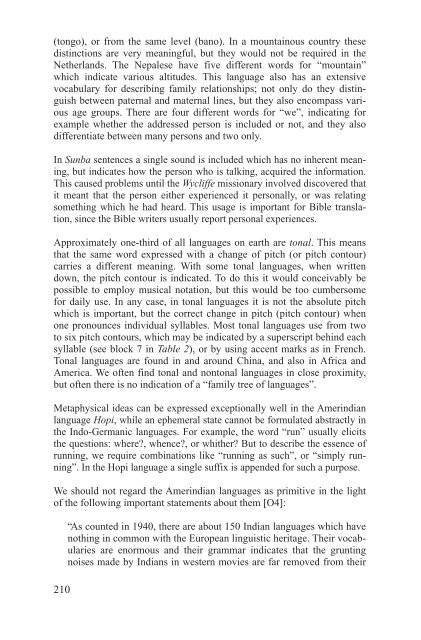In the Beginning was Information
6KezkB
6KezkB
- No tags were found...
You also want an ePaper? Increase the reach of your titles
YUMPU automatically turns print PDFs into web optimized ePapers that Google loves.
(tongo), or from <strong>the</strong> same level (bano). <strong>In</strong> a mountainous country <strong>the</strong>sedistinctions are very meaningful, but <strong>the</strong>y would not be required in <strong>the</strong>Ne<strong>the</strong>rlands. The Nepalese have five different words for “mountain”which indicate various altitudes. This language also has an extensivevocabulary for describing family relationships; not only do <strong>the</strong>y distinguishbetween paternal and maternal lines, but <strong>the</strong>y also encompass variousage groups. There are four different words for “we”, indicating forexample whe<strong>the</strong>r <strong>the</strong> addressed person is included or not, and <strong>the</strong>y alsodifferentiate between many persons and two only.<strong>In</strong> Sunba sentences a single sound is included which has no inherent meaning,but indicates how <strong>the</strong> person who is talking, acquired <strong>the</strong> information.This caused problems until <strong>the</strong> Wycliffe missionary involved discovered thatit meant that <strong>the</strong> person ei<strong>the</strong>r experienced it personally, or <strong>was</strong> relatingsomething which he had heard. This usage is important for Bible translation,since <strong>the</strong> Bible writers usually report personal experiences.Approximately one-third of all languages on earth are tonal. This meansthat <strong>the</strong> same word expressed with a change of pitch (or pitch contour)carries a different meaning. With some tonal languages, when writtendown, <strong>the</strong> pitch contour is indicated. To do this it would conceivably bepossible to employ musical notation, but this would be too cumbersomefor daily use. <strong>In</strong> any case, in tonal languages it is not <strong>the</strong> absolute pitchwhich is important, but <strong>the</strong> correct change in pitch (pitch contour) whenone pronounces individual syllables. Most tonal languages use from twoto six pitch contours, which may be indicated by a superscript behind eachsyllable (see block 7 in Table 2), or by using accent marks as in French.Tonal languages are found in and around China, and also in Africa andAmerica. We often find tonal and nontonal languages in close proximity,but often <strong>the</strong>re is no indication of a “family tree of languages”.Metaphysical ideas can be expressed exceptionally well in <strong>the</strong> Amerindianlanguage Hopi, while an ephemeral state cannot be formulated abstractly in<strong>the</strong> <strong>In</strong>do-Germanic languages. For example, <strong>the</strong> word “run” usually elicits<strong>the</strong> questions: where?, whence?, or whi<strong>the</strong>r? But to describe <strong>the</strong> essence ofrunning, we require combinations like “running as such”, or “simply running”.<strong>In</strong> <strong>the</strong> Hopi language a single suffix is appended for such a purpose.We should not regard <strong>the</strong> Amerindian languages as primitive in <strong>the</strong> lightof <strong>the</strong> following important statements about <strong>the</strong>m [O4]:210“As counted in 1940, <strong>the</strong>re are about 150 <strong>In</strong>dian languages which havenothing in common with <strong>the</strong> European linguistic heritage. Their vocabulariesare enormous and <strong>the</strong>ir grammar indicates that <strong>the</strong> gruntingnoises made by <strong>In</strong>dians in western movies are far removed from <strong>the</strong>ir











![[Pham_Sherisse]_Frommer's_Southeast_Asia(Book4You)](https://img.yumpu.com/38206466/1/166x260/pham-sherisse-frommers-southeast-asiabook4you.jpg?quality=85)




